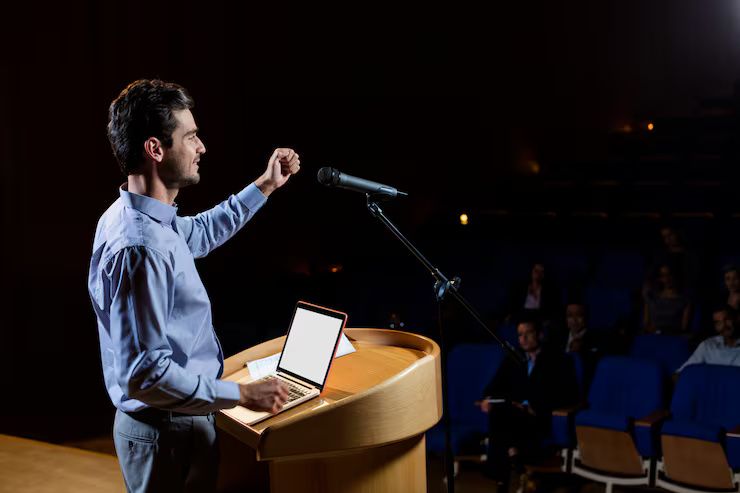The Ultimate Guide to Public Speaking Classes
Public speaking classes are structured educational programs designed to help individuals improve their communication, presentation, and speech delivery skills. These classes often cover techniques such as voice modulation, body language, persuasive speech, and audience engagement.
Whether conducted in person or online, these classes aim to develop confidence and clarity when speaking in front of groups — a skill increasingly valuable in today’s interconnected and media-driven world.

The origins of public speaking date back to ancient Greece, where rhetoric was a key component of civic life. Today, public speaking continues to play a critical role in education, professional development, leadership, and civic engagement.
Why Public Speaking Skills Matter Today
Public speaking is more than just giving a speech—it is about effectively conveying ideas, inspiring action, and building credibility. In today’s environment of remote work, digital platforms, and global audiences, strong verbal communication is essential.
Here’s why public speaking classes are more relevant than ever:
-
Workplace Communication: Professionals are expected to present in meetings, lead webinars, and explain complex information clearly.
-
Academic Success: Students must deliver presentations, defend theses, and engage in discussions that require articulate communication.
-
Personal Confidence: Many individuals join speaking classes to overcome stage fright or anxiety, which can impact social and professional life.
-
Leadership Development: Public speaking is a critical component of leadership, where conveying a clear vision is essential.
-
Entrepreneurship & Sales: Startups and business leaders use speaking skills to pitch ideas, gain investors, or build brand presence.
According to a 2024 LinkedIn Workplace Trends report, "communication" remains among the top five soft skills in demand, with public speaking listed as a top area for professional development.
Recent Trends and Developments in Public Speaking (2024–2025)
Public speaking instruction has evolved significantly, especially in response to hybrid and virtual communication norms. Key developments over the past year include:
| Trend | Description |
|---|---|
| Virtual Training Platforms | Platforms like Coursera, Udemy, and Toastmasters Online now offer AI-driven feedback on tone and delivery. |
| AI-Powered Coaching | Tools such as Orai and Yoodli provide real-time analytics on speaking pace, filler word usage, and clarity. |
| Increased Youth Participation | Schools and colleges have expanded speech and debate programs, particularly after the success of virtual competitions. |
| DEI in Communication | Courses are now including modules on inclusive language and cultural sensitivity in public speaking. |
| Corporate Investment | Many companies now offer paid public speaking programs for employees as part of leadership and talent development. |
In 2025, platforms like Duolingo English Test and TED Masterclass have gained attention for integrating storytelling techniques into their public speaking frameworks.
Legal or Educational Policies Affecting Public Speaking Programs
While there are no direct national laws mandating public speaking instruction, several policies influence its integration in education and corporate training:
-
K–12 Curriculum Requirements: In countries like the United States, Canada, and the UK, public speaking or oral communication is a formal part of language arts curricula.
-
Higher Education Standards: Many universities require public speaking or communications courses as part of general education.
-
Workforce Development Grants: Some governments offer funding for vocational training, including soft skills like communication. For example, the U.S. Department of Labor’s Workforce Innovation and Opportunity Act (WIOA) supports speaking-skills training.
-
Toastmasters International: While not a government program, it often partners with public institutions to provide non-profit training opportunities.
-
Accessibility Laws: Speech training providers must comply with ADA (Americans with Disabilities Act) in the U.S., ensuring access to those with communication or mobility limitations.
Understanding these frameworks helps ensure compliance and access to quality training regardless of background or profession.
Recommended Tools and Resources for Public Speaking Practice
Several tools and platforms can enhance public speaking training for beginners and professionals alike. These include apps, online courses, feedback tools, and templates.
Digital Learning Platforms
-
Coursera / edX – University-level public speaking courses (often free to audit)
-
Skillshare – Creative, storytelling-focused speaking classes
-
Udemy – Budget-friendly speaking classes with reviews and practice exercises
AI Feedback Tools
-
Yoodli – Real-time feedback on filler words, pacing, and eye contact using AI
-
Orai – Mobile app for speech rehearsal with coaching metrics
-
Ummo – Tracks “uhs” and “ums,” clarity, and vocal strength
Practice Communities
-
Toastmasters International – Global community with local clubs for in-person or virtual practice
-
Reddit’s r/publicspeaking – Peer support and real-world experience exchange
Templates & Guides
-
Canva Presentation Templates – Build engaging visual aids
-
TED Talk Outline – Learn the storytelling formula for effective talks
-
Google Slides + Speaker Notes – Structure practice sessions and timing
Frequently Asked Questions (FAQs)
What can I expect to learn in a public speaking class?
Most courses cover structure (openings, body, conclusion), delivery (voice, gestures), and audience interaction. Advanced courses include persuasive techniques, visual aids, and storytelling.
Are online public speaking classes as effective as in-person ones?
Yes, many online classes now include interactive sessions, personalized feedback, and AI analysis. The key is consistent practice and engaging with live audiences, even virtually.
Do I need to have a specific goal to join a speaking class?
Not necessarily. While many join for professional reasons, others take classes to improve confidence, overcome shyness, or develop leadership skills.
How long does it take to become a confident speaker?
It depends on the individual, but with consistent effort, noticeable improvement is possible within 6–12 weeks. Continued practice leads to lasting results.
Is there a certificate for completing a public speaking course?
Yes, platforms like Coursera, edX, and Toastmasters offer certificates, which can be useful for resumes, job applications, or professional development portfolios.
Conclusion
Public speaking is a vital life skill that continues to gain relevance across all sectors. With the rise of digital communication and workplace automation, the human ability to speak clearly and persuasively remains irreplaceable.
Public speaking classes offer structured guidance to help individuals overcome fear, refine their message, and connect meaningfully with audiences. Whether you're a student, entrepreneur, manager, or lifelong learner, developing your public speaking skills is a worthy investment—backed by evolving technology, institutional support, and accessible resources.
By taking advantage of the tools and platforms available today, anyone can begin the journey toward becoming a confident and compelling communicator.
